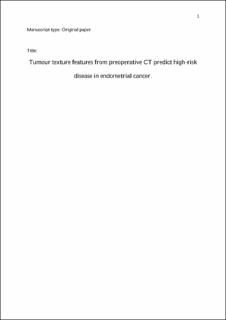| dc.description.abstract | Background: To enable more individualised treatment of endometrial cancer, improved methods for preoperative tumour characterization are warranted. Texture analysis is a method for quantification of heterogeneity in images, increasingly reported as a promising diagnostic tool in oncological imaging, but largely unexplored in endometrial cancer
Aim: To explore whether tumour texture features from preoperative computed tomography (CT) are related to known prognostic histopathological features and to outcome in endometrial cancer patients.
Materials and methods: Preoperative pelvic contrast-enhanced CT was performed in 155 patients with histologically confirmed endometrial cancer. Tumour ROIs were manually drawn on the section displaying the largest cross-sectional tumour area, using dedicated texture analysis software. Using the filtration-histogram technique, the following texture features were calculated: mean, standard deviation, entropy, mean of positive pixels (MPP), skewness, and kurtosis. These imaging markers were evaluated as predictors of histopathological high-risk features and recurrence- and progression-free survival using multivariable logistic regression and Cox regression analysis, including models adjusting for high-risk status based on preoperative biopsy, magnetic resonance imaging (MRI) findings, and age.
Results: High tumour entropy independently predicted deep myometrial invasion (odds ratio [OR] 3.7, p=0.008) and cervical stroma invasion (OR 3.9, p=0.02). High value of MPP (MPP5 >24.2) independently predicted high-risk histological subtype (OR 3.7, p=0.01). Furthermore, high tumour kurtosis tended to independently predict reduced recurrence- and progression-free survival (HR 1.1, p=0.06).
Conclusion: CT texture analysis yields promising imaging markers in endometrial cancer and may supplement other imaging techniques in providing a more refined preoperative risk assessment that may ultimately enable better tailored treatment strategies. | en_US |
